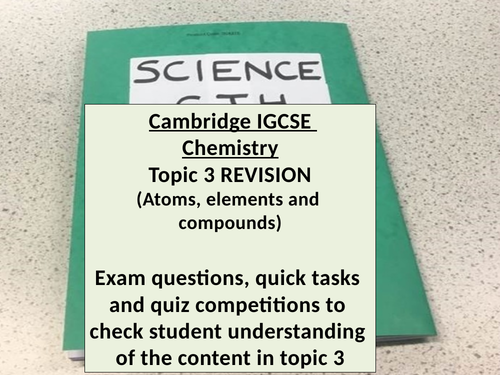

This is an engaging revision lesson which uses a range of exam questions, understanding checks, quick tasks and quiz competitions to enable students to assess their understanding of the content within topic 3 (Atoms, elements and compounds) of the Cambridge IGCSE Chemistry (0620) specification. The lesson covers the content in both the core and supplement sections of the specification and therefore can be used with students who will be taking the extended papers as well as the core papers.
The specification points that are covered in this revision lesson include:
CORE
- State the relative charges and approximate relative masses of protons, neutrons and electrons
- Define proton number (atomic number) as the number of protons in the nucleus of an atom
- Define nucleon number (mass number) as the total number of protons and neutrons in the nucleus of an atom
- Define isotopes as atoms of the same element which have the same proton number but a different nucleon number
- Describe the build-up of electrons in ‘shells’ and understand the significance of the noble gas electronic structures and of the outer shell electrons.
- Describe an alloy, such as brass, as a mixture of a metal with other elements
- Describe the formation of ions by electron loss or gain
- Describe the formation of ionic bonds between elements from Groups I and VII
- Describe the giant covalent structures of graphite and diamond
- Relate their structures to their uses, e.g. graphite as a lubricant and a conductor, and diamond in cutting tools
SUPPLEMENT
- Describe the formation of ionic bonds between metallic and non-metallic elements
- Explain the differences in melting point and boiling point of ionic and covalent compounds in terms of attractive forces
The students will thoroughly enjoy the range of activities, which include quiz competitions such as “The name’s BOND” where they compete to be the 1st to name the type of bond being described whilst crucially being able to recognise the areas of this topic which need their further attention. This lesson can be used as revision resource at the end of the topic or in the lead up to mocks or the actual GCSE exams
Get this resource as part of a bundle and save up to 50%
A bundle is a package of resources grouped together to teach a particular topic, or a series of lessons, in one place.
Something went wrong, please try again later.
This resource hasn't been reviewed yet
To ensure quality for our reviews, only customers who have purchased this resource can review it
Report this resourceto let us know if it violates our terms and conditions.
Our customer service team will review your report and will be in touch.